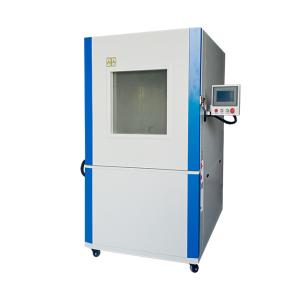
Add to Cart
IEC 60529 IP5X IP6X Sand And Dust Test Chamber

This equipment is suitable for testing electrical and electronic products, automotive and motorcycle parts, and seals in dusty environments to prevent dust from entering seals and housings. This equipment verifies the performance of these products during use, storage, and transportation in dusty environments. The test objective is to determine the potential harmful effects of airborne particles on electrical products. The test can be used to simulate open, dusty air conditions induced by natural or human disturbances, such as vehicle movement.
Two conical funnels are designed with dust collection ports at the bottom. A high-pressure turbine circulating fan intake is installed at the dust extraction port (bottom). This suction is conveyed to the top of the inner chamber, where it is freely dispersed from top to bottom, thus initiating a continuous cycle.
GBT2423.37-2006, Environmental Testing for Electric and Electronic Products - Part 2: Test Methods, Test L: Test Method for La2 in the Dust Test; IEC60068-2-68, Environmental Testing for Electric and Electronic Products - Part 2: Test Methods, Test L: Test Method for La2 in the Dust Test;
GB/T30038-2013, Road Vehicles, Degrees of Protection for Electrical and Electronic Equipment (IP Code), 8.3.1, Figure 1, Dust Test.
Note: This test chamber meets the requirements for enclosure protection of household appliances, low-voltage electrical appliances, automobiles, and motorcycle components in IEC60529, GB2423, GB4706, GB4208, and DIN.
| Workroom Dimensions | 1000×1000×1000mm (W*D*H) |
| External Box Dimensions | Approximately 1500mm (W) * 1500mm (D) * 2100mm (H) |
| Dust Blowing Temperature Range | RT +10°C to 60°C |
| Fine Dust | Under 75µm |
| Coarse Dust | Under 150µm |
| Airflow Velocity | No more than 2m/s |
| Dust Concentration | 2kg/m³ |
| Talc Dosage | 2-5kg/m³ |
| Dust Blowing Method | Top-down |
| Air Flow Meter | 1-20L/m |
| Negative Pressure Differential Range | Adjustable from -10 to 0kPa. Air pressure can be freely set between -2kPa, -5kPa, and -10kPa. |
| Wire Mesh Diameter | 50µm |
| Nominal Interwire Spacing | Under 75µm or 150µm |
| Inner Box Material | SUS201 stainless steel mirror plate |
| Outer Box Material | Plastic-sprayed and painted iron plate |
| Vacuum System | Pressure regulating valve, nozzle, three-piece pressure regulating set, connecting pipe, vacuum pump |
| Dust Heating System | Stainless steel mica heating jacket |
| Circulating Fan | Enclosed alloy low-noise motor, multi-blade centrifugal fan |
| Load Capacity | 20kg |
| Observation Window | 1 unit |
| Lighting | 1 unit |
| Control System | |
| Shock Time | 1s~99h (adjustable) |
| Test Timer | 1s~99h (adjustable) |
| Dust Blowing Control Cycle | 1s~99h (adjustable) |
| Vacuum Time | 1s~99h (adjustable) |
| Controller Functions | (1) Blowing time (stop, blow) h/m/s adjustable; (2) Cycle period adjustable; (3) Preset test time: 0s~999h99m99s adjustable; (4) Power on mode: off-on-off |
| Control System Specimen Power Outlet | Dustproof socket AC220V 16A |
| Control System | PLC controller + touch screen (Teelong) |
| Wiring Process | Complies with national standards, the layout of the electrical panel is reasonable, the wiring is firm, and the markings are clear |
| Safety Protection System | Line sequence protection, leakage protection, abnormal protection, alarm sound prompt, etc. |
| Power supply: AC 380V, three-phase, five-wire, 50Hz. A separate 32A air switch with terminal blocks is required. Power cord ≥ 4 sq.m. | |
| Environmental conditions: Temperature (23 ± 5)°C; Relative humidity 25% to 70% RH; Atmospheric pressure 86 to 106 kPa | |
| Power: 6 kW (no-load) | |
|
Test equipment prohibited | 1. Testing or storage of biological samples; 2. Testing or storage of samples containing highly toxic substances; 3. Testing or storage of samples containing radioactive substances; 4. Testing or storage of samples containing corrosive substances; 5. Testing or storage of samples containing strong electromagnetic radiation sources; 6. Testing or storage of samples containing flammable, explosive, or volatile substances; 7. Testing or storage of samples that may produce highly toxic substances during testing or storage. |